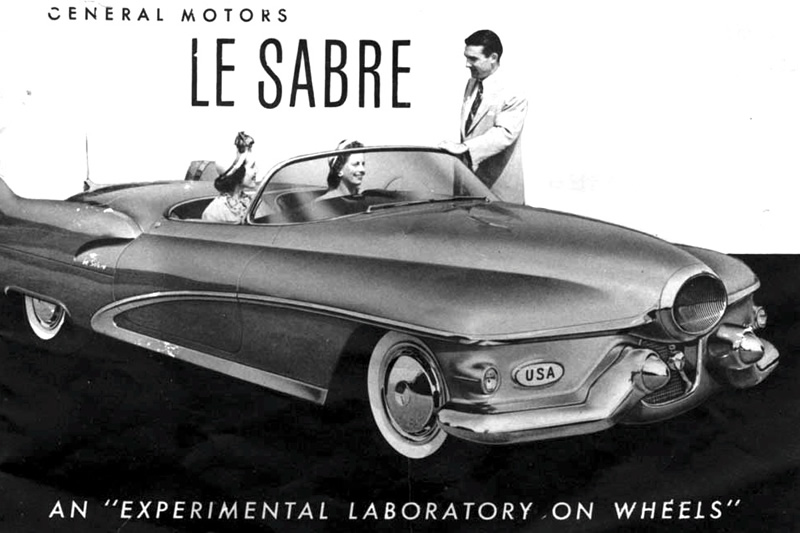The LeSabre nameplate made its first appearance on the
1951 Le Sabre show car, which introduced the world to aircraft-inspired design elements such as the wrap-around windshield and tail fins. There is a V8 for the Buick LeSabre (5.00 litre) which originated in
1953. In
1959 LeSabre became the new moniker for what had previously been known as the Buick Special. The Buick LeSabre was offered in a full line of
body styles except between
1965 -
1969 when its station wagon variant was dropped from Buick's full-size offerings. In
1977, the LeSabre was downsized along with other GM full-size models, and was available only in pillared coupe, sedan and wagon body styles.
In addition to being Buick's entry level vehicle, the LeSabre was consistently Buick's best selling full-size car. Of the four nameplates introduced in 1959 (LeSabre, Invicta, Electra, Electra 225), the LeSabre nameplate lasted the longest. From
1959 to
1961, the LeSabre was powered by a 364 cubic-inch V8, which was smaller than the 401 cubic-inch V8 used in the more expensive Invicta and Electra models. The 364, which was previously used in all Buicks in
1957 and
1958, was rated at 250 horsepower (190 kW) in standard form with an "economy" 235 horsepower (175 kW) version offered as a "no cost" option in 1960-61 and an optional power-pack version with four-barrel carburetor and dual exhausts that was rated at 300 horsepower (220 kW).
For
1962 -
1963, the LeSabre came standard with a two-barrel carbureted version of the 401 V8 rated at 280 horsepower (210 kW), or a no-cost "economy" low-compression version rated at 260 horsepower (190 kW). Starting in 1964, all LeSabre models except the Station Wagon shared their drivetrains with the mid size Buick models by switching to those models' smaller-displacement V8s at least as standard equipment for the next few years with cubic-inch displacements of 300 (
1964 –
1965), 340 (
1966 –
1967) and 350 (
1968 –
1976). A large-displacement would not reappear in a LeSabre until
1970 when a 455 cubic-inch V8 was introduced as an option and was offered through 1976. Beginning with the downsized 1977 models and continuing through three subsequent generations of front-drive LeSabres introduced in
1986, 1992 and 2000, Buick's 3.8-litre (231 cubic-inch) V6 would become the standard engine for most LeSabre models and V8 engines were dropped (except in station wagons) after the last of the rear-drive LeSabre sedans and coupes came off the line in
1985.
1961and
1962, the
automatic transmission was standard on the LeSabre and all other full-sized Buicks but in
1963 was moved back to the option list on LeSabres. For
1964, the Dynaflow-based Turbine Drive was replaced by two new automatic transmissions, the two-speed Super Turbine 300 and the three-speed Super Turbine 400. A four-speed manual
transmission was offered as a LeSabre option from
1963 to
1965 but only a small number of cars were so equipped. Automatic transmissions would once again reappear as standard equipment on LeSabres in mid-
1971 and continue in such form until the model line's demise after 2005.
Also see: The History of Buick (USA Edition)



